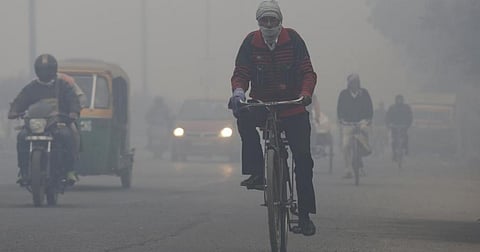Union Budget 2020-21 promises Rs 4,400 cr for clean air; how, where and how soon?
For those awaiting real money for clean air action, it is encouraging that Nirmala Sitharaman in Union Budget 2020-21 allocated Rs 4,400 crore for million-plus cities “formulating and implementing plans for ensuring cleaner air”. While doing so the finance minister acknowledged that air pollution in big cities is a “matter of concern”.
But this commitment has not yet been defined. According to Sitharaman, “parameters for the incentives would be notified by the Ministry of Environment, Forests and Climate change.”
The ministry-wise budget shows that this amount has not yet been allocated in the total budgetary allocation of the environment ministry for the coming year, which is about Rs 3,100 crore.
The proposed allocation of Rs 4,400 crore for clean-air action for million-plus cities, if parked in the same environment ministry, will be 1.41 times higher than its total budget. It will be nearly 10 times the current allocation of Rs 460 crore for pollution control, including National Clean Air Programme (NCAP).
All are curious about the nature, its parking and administration of this fund.
The 2011 Census identified 46 cities with a population of more than a million. We do not know if all of them qualify for the funds; or only those identified as non-attainment cities for not meeting the national ambient air quality standards for particulate matter (PM) 10 and PM2.5 under NCAP.
Last year, some 28 of the non-attainment cities qualified for a small grant of Rs 10 crore each under NCAP. If the same cities qualify for the new moolah, this may translate to Rs 1,571.4 crore per city for clean air action plan implementation. But a lot less if all 122 non-attainment cities or the larger polluted regions make claims.
Adequacy of this amount and its leveraging of other sectoral funds will have to be assessed in relation to the nation-wide NCAP reduction target.
The Environment Ministry’s actual routine allocation for ‘control of pollution’ — conceptualised to provide financial assistance to pollution control boards / committee and NCAP — has increased marginally to Rs 460 crore from Rs 445 crore.
At this moment we also do not know how this routine allocation will be spent. The accompanying budget document on ‘Output and Outcome Framework 2020-21’ for major central sector and centrally sponsored schemes shows that even after one year of NCAP, indicators for output and outcome for this programme are not available.
So far the spending on NCAP has remained limited to expansion of air quality monitoring, source assessment studies and dust-control measures. There is still quite a limited view of what is going on.
The new Economic Survey has highlighted only central spending to control agricultural crop burning and efforts in Delhi to recycle construction and demolition waste as air pollution control measures. It has neglected reporting on NCAP, which is supposed to be the new flagship programme on clean air.
Spend the money well
Substantial new money is surely needed as budgetary commitment to power change and make NCAP real.
About 70 per cent of the cities monitored are critically polluted and 95 per cent Indians breathe air that worse than World Health Organization; some 1.2 million people die prematurely every year from air pollution-related diseases. The health risk is fairly equally distributed across India — not just cities but larger regions, like the Indo-Gangetic Plain, are engulfed in blanket of smog.
Considering these, the fiscal strategy has to enable scale and effectiveness for verifiable reduction to comply with the NCAP target nationally. That certainly needs significant step up in spending across sectors and regions.
The multi-sector action to cut emissions at source and to tame regional movement of pollution with strong compliance and deterrence framework has to accompany financial leveraging. At this moment, the explicit sector specific proposal for air pollution action in the budget is the proposal to retire old power plants and those not meeting the standards.
While this must happen with a firm roadmap, going forward fiscal strategy has to address clean energy pricing in all sectors, funding mobility and transportation solutions at a massive scale, and management of waste to stop open burning.
Current pricing and taxation regime is still working against clean fuels and public transport. The new budget has ignored these key areas of interventions. It is also hugely focused on infrastructure spending that if not planned and designed well based on sustainability principles can also lock in enormous pollution and carbon in the future.
The Finance Minister has stated in her speech that the final report of the 15th Finance Commission is due this year. It was earlier reported that the commission has deliberated on environment and pollution abatement performance for grant for states and measurable performance-based incentives for states, among others.
This idea needs to be taken forward.
The new budgetary step, which is also a tacit political acknowledgement of the public health emergency, has to gather momentum to step up fiscal solutions for killer air.


